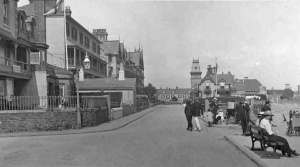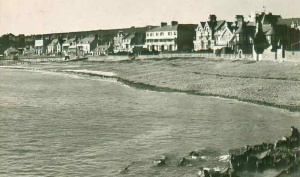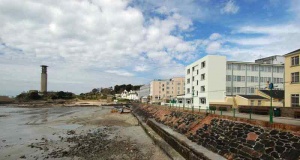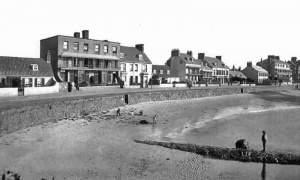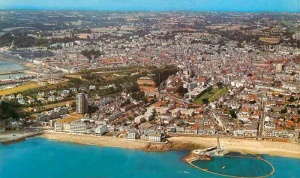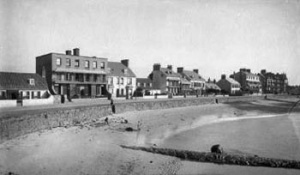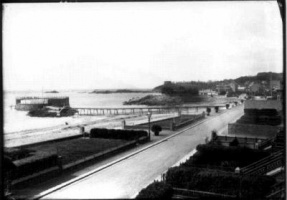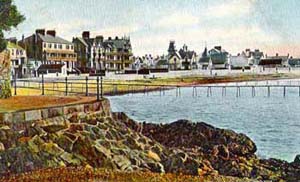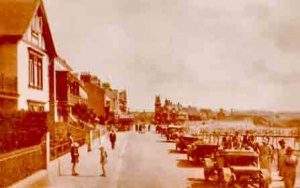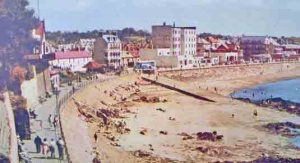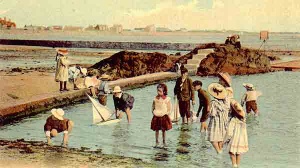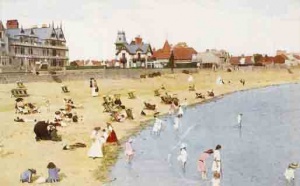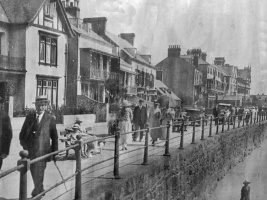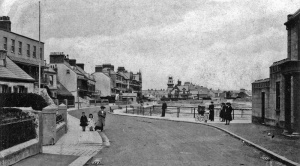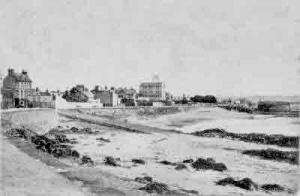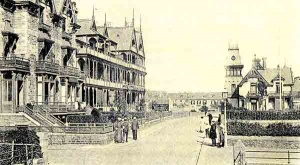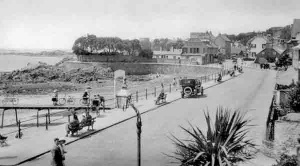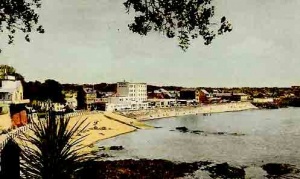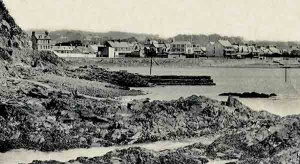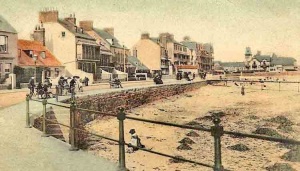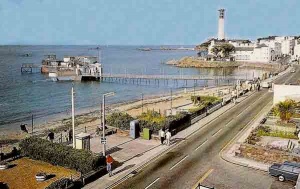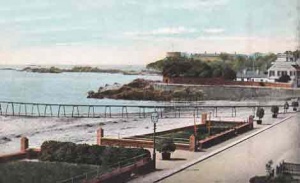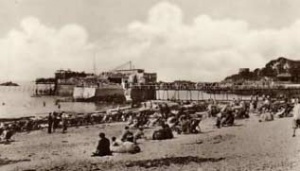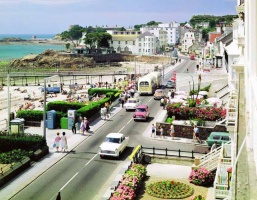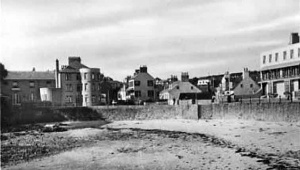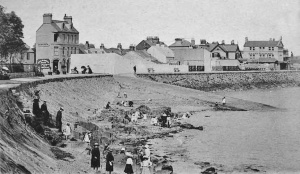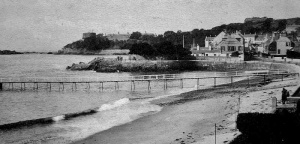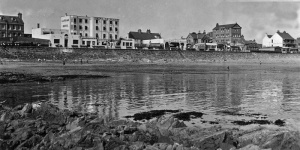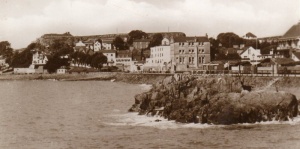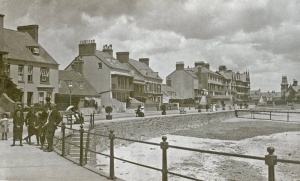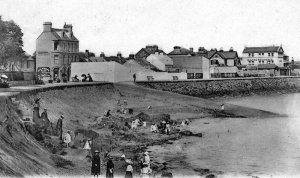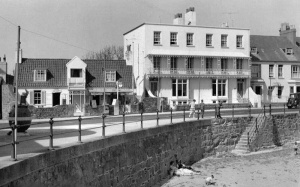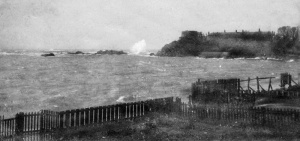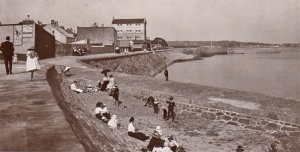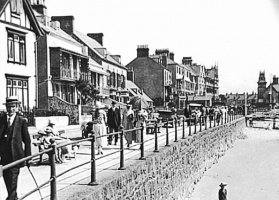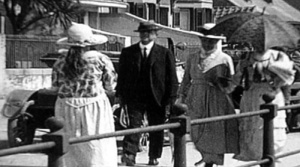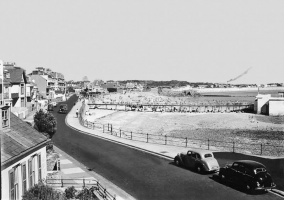On the coast
|
|
Havre des Pas
Havre des Pas in 1921 When the town of St Helier began to spread outwards in the second half of the 18th century, a natural choice for new housing was along the parish's southern coast at Havre des Pas, separated from the town centre then by sand dunes and open fields.
|
Derivation of name
The area had long been a natural harbour for small vessels, giving the first part of its name. Des Pas refers to marks on a rock further inland which appear like footprints and were declared to be made by the Virgin Mary when a chapel was built over them in the 12th Century. Or that's the usual explanation, but in an article for the 1968 Annual Bulletin of La Société Jersiaise, Philip Ahier has a different explanation.
He wrote that the area was named after the Chapelle des Pas, a medieval chapel, the full name of which was Notre dame de Pace - Our Lady of the Peace, and that 'pas' was a contraction of 'pace'. However, this seems to be a strange mixture of French and Latin, and the common French title for churches named after the Blessed Virgin Mary is Notre Dame de la Paix. It is still, of course, possible that 'pas' was derived from this name. The chapel was demolished in 1814.
Earliest mention
The first documentary reference to Havre des Pas in in an Act of the States of 14 May 1585, when it became the responsibility of Servais le Vavasseur de Bois, who was a collector of import duties on wines and spirits.
In November 1643 the Parliamentarian Governor left the island in a hurry from Havre des Pas after Sir George Carteret landed at the other end of the island to reclaim it for the Crown. He is said to have left with his wife, father-in-law and mother-in-law leaving their supper untouched on the table. Three years later Royalist Sir Henry Killigrew died of a fever in St Malo having been wounded in the head in the defence of Pendennis Castle in Cornwall. He had expressed a desire to be buried in Jersey and his embalmed body was transported to arrive at Havre des Pas.
In Col Legge's Accompt of Jersey, 1679 there is a reference to a peare approximately 100 metres long at Havre du Pas. This seemingly substantial structure must have been washed away before Havre des Pas was under consideration as a new harbour for St Helier towards the end of the 17th century. It was ruled out because it was on the wrong side of Mont de la Ville from the town and the approach through rocks was deemed to be far too dangerous for any but the smallest of vessels.
Shipyards
Before the land along the coast began to be developed, a number of shipyards were sited there, that last surviving into the 20th century. Many of the early buildings were small cottages occupied by workers in the shipyards, but gradually some grander houses began to be built and then, towards the end of the 19th century the area became a fashionable seaside suburb with hotels and boarding houses. Although some properties have been demolished or had extensions built over the decades, many fine examples of traditional Victorian seaside architecture remain and are now protected.
Pool
A major attraction was created by the building of the bathing pool, which opened on 12 March 1895. It was built by the Jersey Swimming Club at a cost of £3,106 12s 9d. Initially there was a circular granite wall to hold water between high and low tides in a pool for the exclusive use of ladies. Men were restricted to bathing off the rocks and diving stages to the west of the pool, but there were plans to build a separate pool for them. Progressively the ladies pool was developed with changing rooms and a promenade and men were allowed to use the facilities on their own at certain times. In 1904 mixed bathing was permitted between the hours of 9 o'clock and 10.30 in the morning.
The pool grew in popularity and was further developed in the 1920s. In its heyday it was a centre of island social life, as well as a base for the island's top swimmers and divers. It was modernised in 1925 with the addition of the Blue Terrace, and a pavilion was added two years later to host dances and other social events. Although it remains in use after major restoration work at the end of the 20th century, it could not retain its popularity when the Jersey Swimming Club, which originally built and ran the pool, transferred to the heated pool at Fort Regent.
- History of Havre des Pas Pool
- Reminiscences of Havre des Pas: A 1972 letter
Archive presentation
Havre des Pas featured in the Jersey Archive What's your story? series on Jersey streets and districts in 2010. The presentation charted the development of the area into a fashionable Victorian suburb of St Helier and a magnet for early holidaymakers. These are extracts from the full presentation:
- "The Richmond map of 1795 shows that few properties existed – mainly clustered around the Dicq area and towards Green Street. The land now occupied by Marrett Road, Roseville Street and Cleveland Road, and the land at Grève d’Azette, consisted of fields and sand dunes. The map does show a building in the location of the Fort D’Auvergne Hotel on the promenade at Havre des Pas. This building, La Garde du Havre des Pas, was constructed in about 1756 and formed part of the increased fortification of the Island’s coastline. It was renamed Fort d'Auvergne about 1833 in honour of Major-General James d'Auvergne. It consisted of a boulevard, powder magazine and two guns.
- "The importance of the Island’s military position and threat of invasion after the Battle of Jersey were factors in the decision to construct additional fortifications at the Mont de la Ville in the early 1800s. These fortifications were to become what we now know as Fort Regent and their construction and subsequent garrisoning influenced the development of the western part of Havre des Pas. Green Street was the original site of the married quarters for soldiers from the garrison.
Government cottages
- "The 1861 census describes these quarters as Government Cottages and lists the names of a Master Gunner, Bombardier in the Royal Artillery and Captain in the Army. One of those mentioned is Samuel Thompson a 34-year-old Corporal in the Royal Artillery from Ireland who lived with his wife Mary and their two sons, Samuel and John. The family had two additional children in the early 1860s, William Herbert and Agnes Mary. Sadly tragedy struck the family when Samuel died. Mary presumably struggled to look after four young children and in 1869 two of the boys, Samuel and William were admitted to the Jersey Home for Boys.
Shipbuilding
- "The shipbuilding community at Havre des Pas flourished with many yards being established at this time including those of Francis Allix, 1847–1877, Thomas Bisson, 1856–1873, Edward Nicolle, 1824–1835, Matthew Philip Valpy, 1837–1868 and Le Vesconte and Vautier, 1854–1858.
- "The ships built at Havre des Pas sailed around the globe and included the Asia, a 97-ton schooner, built at the yard of Francis Allix, registered in 1850 and lost off Madagascar in 1865. Allix ships were also lost in seas as far afield as New Zealand and Florida. The site of the Allix shipyard can still be seen on the promenade at Havre des Pas, where a public open space celebrates the shipbuilding heritage of the area.
- "Francis Allix was born in 1815, the son of Jean and Elizabeth Godel. In May 1847 he married Betsy Mary Ann Landhatherland, daughter of Richard Landhatherland – the owner of Holyrood House located near the Allix shipyard. It was also in 1847 that the first ship to be built under Francis’ name was registered.
- "By 1851 Francis and Betsy are recorded as living at Mont Aubin Cottage at Havre des Pas with their two sons. By looking at the West of England Insurance registers from the 1850s we can see that Francis has insured his property. He pays to insure his own house, 2 Mont Aubin Cottage, and also insures the models and utensils of his trade. Francis is also paying insurance on 2 Pigeon’s Public House at Havre des Pas. It is thought that Pigeon’s Public House was originally owned by the Landhatherland family. The building, next to Holyrood House is still run as a bar.
- "In the 1881 census Francis is listed as living in the Landhatherland home – Holyrood House. Later that year he died leaving a large amount of property at Havre des Pas to his two sons, Francis Richard Land Allix and Richard Francis Land Allix. Between them the brothers inherited the workshops and shipyard, Holyrood House, Derby House, 1, 2 and 3 Sidon Place, Eden Villa, Stanley Lodge, Stanley House and land in the Havre des Pas area. The brothers' property holdings increased in 1899 when they inherited Fort d’Auvergne, Fort d’Auvergne Cottage and Mont Aubin from their great aunt Marianne Landhatherland.
Fort d'Auvergne
- "As the shipping industry declined the growth in visitors led to the development of hotels and guesthouses where there were once shipbuilding yards. Many of the Allix family properties were listed as lodging houses in the 1881 census.
- "Lodgers at Fort d’Auvergne House included Alexander McDonall, a journalist from England who was travelling with his mother Juliana, born in the East Indies; aunt, Anne Lindsay and two lady’s maids.
- "Fort d’Auvergne House was brought from the Allix Family by George Thomas Day in 1925. When Day sold the property in 1930 to Alfred Cabeldu it was described as a Hotel and was run by the Cabeldu family as a thriving business before and after the Occupation. During the Occupation the Hotel was requisitioned by the Germans and used by German officers.
Further articles
- Le Havre des Pas
- Fort d'Auvergne Hotel
- Havre des Pas Aquarium
- A comparison of the beach between 1956 and 2016
- Coast: Havre des Pas, one of the stops on our coastal tour of Jersey NEW
Commemorative plaques
Gallery



These are general views of Havre des Pas. For pictures of the pool see the gallery accompanying our history of the pool.
Ladies only!


1880s photograph by Philip Godfray
Havre des Pas viewed from La Collette
An early photograph looking across to La Collette at high tide






















